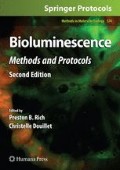Abstract
Bioluminescence using the reporter enzyme firefly luciferase (Fluc) and the substrate luciferin enables non-invasive optical imaging of living animals with extremely high sensitivity. This type of analysis enables studies of gene expression, tumor growth, and cell migration over time in live animals that were previously not possible. However, a major limitation of this system is that Fluc activity is restricted to the intracellular environment, which precludes important applications of in vivo imaging such as antibody labeling, or serum protein monitoring. In order to expand the application of bioluminescence imaging to other enzymes, we characterized a sequential reporter-enzyme luminescence (SRL) technology for the in vivo detection of β-galactosidase (β-gal) activity. The substrate is a “caged” d-luciferin conjugate that must first be cleaved by β-gal before it can be catalyzed by Fluc in the final, light-emitting step. Hence, luminescence is dependent on and correlates with β-gal activity. A variety of experiments were performed in order to validate the system and explore potential new applications. We were able to visualize non-invasively over time constitutive β-gal activity in engineered cells, as well as inducible tissue-specific β-gal expression in transgenic mice. Since β-gal, unlike Fluc, retains full activity outside of cells, we were able to show that antibodies conjugated to the recombinant β-gal enzyme could be used to detect and localize endogenous cells and extracellular antigens in vivo. In addition, we developed a low-affinity β-gal complementation system that enables inducible, reversible protein interactions to be monitored in real time in vivo, for example, sequential responses to agonists and antagonists of G-protein-coupled receptors (GPCRs). Thus, using SRL, the exquisite luminescent properties of Fluc can be combined with the advantages of another enzyme. Other substrates have been described that extend the scope to endogenous enzymes, such as cytochromes or caspases, potentially enabling additional unprecedented applications.
Access this chapter
Tax calculation will be finalised at checkout
Purchases are for personal use only
References
Wu, J. C., Chen, I. Y., Wang, Y., Tseng, J R., Chhabra, A., Salek, M., Min, J. J., Fishbein, M. C., Crystal, R., and Gambhir, S. S. (2004) Molecular imaging of the kinetics of vascular endothelial growth factor gene expression in ischemic myocardium. Circulation 110 , 685–691.
Contag, P. R., Olomu, I. N., Stevenson, D. K., and Contag, C. H. (1998) Bioluminescent indicators in living mammals. Nat Med 4 , 245–247.
Contag, C. H., Contag, P. R., Mullins, J. I., Spilman, S. D., Stevenson, D. K., and Benaron, D. A. (1995) Photonic detection of bacterial pathogens in living hosts. Mol Microbiol 18 , 593–603.
Edinger, M., Sweeney, T. J., Tucker, A. A., Olomu, A. B., Negrin, R. S., and Contag, C. H. (1999) Noninvasive assessment of tumor cell proliferation in animal models. Neoplasia 1 , 303–310.
Gross, S., and Piwnica-Worms, D. (2005) Real-time imaging of ligand-induced IKK activation in intact cells and in living mice. Nat Methods 2 , 607–614.
Zhao, H., Doyle, T. C., Coquoz, O., Kalish, F., Rice, B. W., and Contag, C. H. (2005) Emission spectra of bioluminescent reporters and interaction with mammalian tissue determine the sensitivity of detection in vivo. J Biomed Opt 10 , 41210.
Wehrman, T. S., von Degenfeld, G., Krutzik, P. O., Nolan, G. P., and Blau, H. M. (2006) Luminescent imaging of beta-galactosidase activity in living subjects using sequential reporter-enzyme luminescence. Nat Methods 3 , 295–301.
Geiger, R., Schneider, E., Wallenfels, K., and Miska, W. (1992) A new ultrasensitive bioluminogenic enzyme substrate for beta-galactosidase. Biol Chem Hoppe Seyler 373 , 1187–1191.
Miska, W., and Geiger, R. (1987) Synthesis and characterization of luciferin derivatives for use in bioluminescence enhanced enzyme immunoassays. New ultrasensitive detection systems for enzyme immunoassays, I. J Clin Chem Clin Biochem 25 , 23–30.
Miska, W., and Geiger, R. (1988) A new type of ultrasensitive bioluminogenic enzyme substrates. I. Enzyme substrates with D-luciferin as leaving group. Biol Chem Hoppe Seyler 369 , 407–11.
Cali, J. J., Ma, D., Sobol, M., Simpson, D. J., Frackman, S., Good, T. D., Daily, W. J., and Liu, D. (2006) Luminogenic cytochrome P450 assays. Expert Opin Drug Metab Toxicol 2 , 629–645.
Shah, K., Tung, C. H., Breakefield, X. O., and Weissleder, R. (2005) In vivo imaging of S-TRAIL-mediated tumor regression and apoptosis. Mol Ther 11 , 926–931.
Monsees, T., Miska, W., and Geiger, R. (1994) Synthesis and characterization of a bioluminogenic substrate for alpha-chymotrypsin. Anal Biochem 221, 329–334.
Geiger, R., and Miska, W. (1989) A new type of ultrasensitive bioluminescence enzyme substrates for kininases. Adv Exp Med Biol 247B, 383–388.
von Degenfeld, G., Wehrman, T. S., Hammer, M. M., and Blau, H. M. (2007) A universal technology for monitoring G-protein-coupled receptor activation in vitro and noninvasively in live animals. Faseb J 21 , 3819–3826.
Banfi, A., Springer, M. L., and Blau, H. M. (2002) Myoblast-mediated gene transfer for therapeutic angiogenesis. Methods Enzymol 346 , 145–157.
Springer, M. L., Rando, T. A., Blau, H. M., Banfi, A., Springer, M. L., and Blau, H. M. (2002) Gene delivery to muscle. Myoblast-mediated gene transfer for therapeutic angiogenesis. Curr Protoc Hum Genet Chapter 13, Unit 13 4.
Author information
Authors and Affiliations
Editor information
Editors and Affiliations
Rights and permissions
Copyright information
© 2009 Humana Press, a part of Springer Science+Business Media, LLC
About this protocol
Cite this protocol
von Degenfeld, G., Wehrman, T.S., Blau, H.M. (2009). Imaging β-Galactosidase Activity In Vivo Using Sequential Reporter-Enzyme Luminescence. In: Rich, P., Douillet, C. (eds) Bioluminescence. Methods in Molecular Biology™, vol 574. Humana Press, Totowa, NJ. https://doi.org/10.1007/978-1-60327-321-3_20
Download citation
DOI: https://doi.org/10.1007/978-1-60327-321-3_20
Published:
Publisher Name: Humana Press, Totowa, NJ
Print ISBN: 978-1-60327-320-6
Online ISBN: 978-1-60327-321-3
eBook Packages: Springer Protocols

